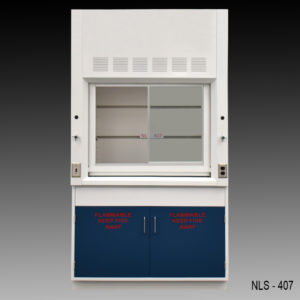Though hazardous vapors and gases are dangerous, many professionals handle these hazardous materials every day. Fume hoods and flow hoods exist to protect personnel from exposure to harmful substances. However, they are not the same device. Depending on the type of work being performed, you will have to decide whether a fume hood or flow hood may be most appropriate.
Although both of these devices work to exhaust the air of dangerous particles, there are differences in how they operate and the primary function that they serve.
Fume Hood
A laboratory fume hood is a ventilated enclosure that allows laboratory personnel to conduct hazardous work in an enclosed space. Fume hoods work to protect users from inhaling harmful vapors by continuously exhausting the airflow away from the workstation and out of the laboratory. The sash also serves as a shield to protect the user in the event of an explosion or fire.
Flow Hood
A laminar flow hood is an enclosed workstation designed to prevent contamination and provide a sterile work area for biological experiments. Used for substances that require the utmost purity, such as harmful, disease-causing organisms, the air is moved through a high-efficiency particulate air (HEPA) filter and pushed in a laminar flow through the work area. Unlike fume hoods, which only work to protect lab personnel, flow hoods protect both personnel and the materials involved. The pure airflow keeps materials free of contaminants and airborne substances.
Protection
The primary function of a fume hood is to protect the user from inhaling toxic substances. They also provide limited protection in the event of an explosion or spill.
A laminar flow hood not only protects personnel but also protects the substance from contamination as well. Also, because of the use of HEPA filters, laminar flow hoods provide environmental protection as well.
Airflow
As air flows through the middle of the fume hood, it pushes the harmful gases, vapors, and fumes towards the exhaust area. Often through ductwork, the toxic air is diluted and released into the atmosphere. On ductless fume hoods, the air is filtered and recirculated back into the room.
Laminar flow hoods have two airflow patterns, vertical and horizontal. In a vertical flow hood, the filtered air flows downward toward the working bench. In a horizontal flow hood, the filtered air flows horizontally through the cabinet. Regardless of the flow of air, there are three kinds of laminar flow hoods that have been developed to meet various research and clinical needs:
Class I laminar flow hoods offer significant protection for personnel and the environment. The air flows from the laboratory into the chamber in a similar design to chemical fume hoods.
Class II laminar flow hoods are designed for work involving BSL-1, 2, and 3 materials. The air flows from the laboratory into the chamber while also flowing downward toward the working surface. The exhaust air is sent through a HEPA filter before being released into the environment. A Class II laminar flow hood should always be used when handling virally infected cultures, radioisotopes, and carcinogenic or toxic reagents.
Class III laminar flow hoods are gas-tight and provide the highest level of protection for personnel and the environment. Air that enters or exits the chamber is passed through a HEPA filter. Class III laminar flow hoods are required when working with known human pathogens and BSL-4 materials.
Fume Hood vs Flow Hood
Fume hoods and flow hoods may serve different purposes, but both are critical to laboratories and personnel. They allow for tasks to be completed while keeping personnel safe. When used properly, lab personnel can assure themselves a safe work environment when handling toxic chemicals or disease-causing microorganisms.
Related Resources:
What is the Top Fume Hood Brand?
How Much Does a Fume Hood Cost?
Fume Hoods and Biosafety Equipment: What is the difference?

